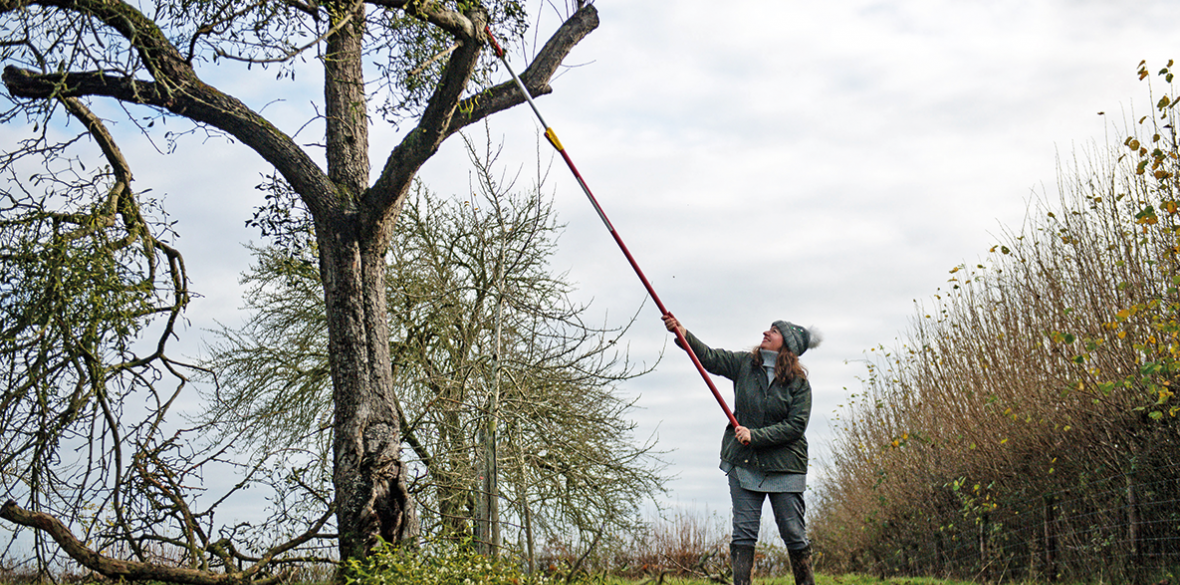This is the last article you can read this month
You can read more article this month
You can read more articles this month
Sorry your limit is up for this month
Reset on:
Please help support the Morning Star by subscribing here
I HAVE always thought the mistletoe (Viscum album) was one of the most magical and mysterious of plants. I have seen huge and multitudinous bunches growing on gnarled and ancient apple trees but similar orchards with not a sign of the plant.
I’ve also seen pathetic pale bunches over the door at more Christmas office parties than you could shake a cracker at.
Experts, face to face as well as on the media, tell me it is almost impossible to cultivate mistletoe, although I have read about making a nick in an ancient apple tree’s bark and rubbing in the seeds and pulp of a mistletoe berry. I’ve never met anyone who has managed to get mistletoe to take hold by this method.
If you are tempted to try it do be very careful — the berries are extremely poisonous.
It doesn’t need to be an apple tree — the kissing bough, as it is often named — isn’t very fussy when it comes to choosing a tree in which to make its home.
Mistletoe is, of course, a parasitic plant. These parasites are attached to their host tree or shrub by a structure called the haustorium, through which they extract water and nutrients from the host plant. They don’t have roots that grow into the ground.
Our mistletoe has smooth-edged, oval, evergreen leaves borne in pairs along the woody stem, and waxy, white berries in clusters of two to six.
Some of the wide range of host trees can experience side effects including reduced growth, stunting and loss of infested outer branches. A heavy infestation may also kill the host tree.
Mistletoe has been used historically in medicine for its supposed value in treating arthritis, high blood pressure, epilepsy and infertility. Any such use attempted treatment can be extremely dangerous indeed fatal.
Mistletoes are often considered pests that kill trees and devalue environmental habitats, but some species have recently been recognised as ecologically important.
A number of animals depend on mistletoe for food, consuming the leaves and young shoots. They transfer pollen between plants and disperse the sticky seeds.
When eaten by birds some seeds pass unharmed through their digestive systems; if the birds’ droppings happen to land on a suitable branch, the seeds may stick long enough to germinate.
If the seed sticks and germinates, the plant may mature and grow into masses of branching stems which suggest the popular name “witches’ brooms.”
Mysterious mistletoe is important to several cultures. Pagan cultures regarded the white berries as symbols of male fertility, with the seeds resembling semen.
The Celts, particularly, saw mistletoe as the semen of Taranis — the god of thunder, while the ancient Greeks referred to mistletoe as “oak sperm.” Also in Roman mythology, mistletoe was used by the hero Aeneas to reach the underworld.
Mistletoe may have played an important role in Druidic mythology in the Ritual of Oak and Mistletoe, although the only ancient writer to mention the use of mistletoe in this ceremony was Pliny.
Evidence taken from bog bodies seems to sugest the Celtic use of mistletoe was medicinal rather than ritual.
The Romans associated mistletoe with peace, love and understanding and hung it over doorways — now there is a clue — to protect the household.
In the Christian era, mistletoe in the Western world became associated with Christmas, as a decoration under which lovers are expected to kiss, as well as with protection from witches and demons.
Mistletoe continued to be associated with fertility and vitality through the Middle Ages, and by the 18th century it had also become incorporated into Christmas celebrations around the world.
The custom of kissing under the mistletoe is referred to as popular among servants in late 18th century England. The serving class of Victorian England is credited with perpetuating the tradition.
Young footmen as well as lecherous masters of the house pursue attractive young housemaids in many a Victorian melodrama and the mistletoe could only help.
Tradition dictated that a man was allowed to kiss any woman standing underneath mistletoe, and that bad luck would befall any woman who refused the kiss. Bet that tradition was invented by a man.
One variation on the tradition stated that with each kiss a berry was to be plucked from the mistletoe, and the kissing must stop after all the berries had been removed.
Over centuries mistletoe has been used as treatment of many diseases in traditional and folk medicine. To date, anti-cancer, immunomodulatory, cardiac, antidiabetic, hepatoprotective, neuropharmacological, antibacterial and anti-fungal properties of mistletoe extracts have been studied the most.
This study goes on. Research is going on in Bristol to use mistletoe extracts to help with the side effects of chemotherapy in cancer patients.
I’m no doctor and I am reluctant to try to judge which are genuine conventional medical uses and what are simply alternative cures based on the plant’s magical reputation rather that real-life trials.
Just remember, a kiss under the mistletoe from the one you love is the best medicine of all.









